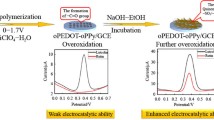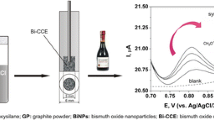Abstract
In this study, we investigated the electrochemical determination of syringic acid using palladium nanoparticles dispersed zirconium metal-organic framework composite. Transmission electron microscopic images illustrated that the average diameter of < 10 nm spherical Pd nanoparticles was decorated on the surface of the metal-organic framework. Cyclic voltammetric analysis showed that the composite exhibited well-defined oxidation (0.61 eV) and reduction (0.48 eV) peaks toward the determination of syringic acid in 0.1 M phosphate buffer saline (pH 3). In addition, the composite electrode demonstrated higher currents than the bare glassy carbon electrode and pure metal-organic framework. The differential pulse voltammetric analysis showed that the composite electrode manifested a dynamic linear range of concentrations from 0.5 to 100 µM with a regression equation of I (µA) = 0.3217x + 5.8055 (R2 = 0.9981). The sensitivity and detection limit of the composite electrode were identified as 0.32 µA/µM and 0.17 µM, respectively. The composite electrode demonstrated good anti-interference properties towards benzoic acid, routine, caffeic acid, sinapic acid, and KCl. The composite electrode was used to determine the syringic acid level in wine samples with good recoveries (99 to 103%), indicating its feasibility for practical applications in the pharmaceutical sector.






Similar content being viewed by others
Data availability
Data sharing is not applicable to this article as no datasets were generated or analyzed during the current study.
References
L.M. Ramirez-Lopez, W. McGlynn, C.L. Goad, C.A.M. DeWitt, Simultaneous determination of phenolic compounds in cynthiana grape (Vitis aestivalis) by high-performance liquid chromatography-electrospray ionization-mass spectrometry. Food Chem. 149, 15–24 (2014)
T.S. Fukuji, F.G. Tonin, M.F.M. Tavares, Optimization of a method for determination of phenolic acids in exotic fruits by capillary electrophoresis. J. Pharm. Biomed. Anal. 51, 430–438 (2010)
R.Y. Gan, C.L. Chan, Q.Q. Yang, H.B. Li, D. Zhang, Y.Y. Ge, A. Gunaratne, J. Ge, H. Corke, Bioactive compounds and beneficial functions of sprouted grains, in Sprouted grains: nutritional value, production, and applications. ed. by B.H. Feng, B. Nemzer, J.W. DeVries (Elsevier, Amsterdam, 2019), pp.191–246
R.J. Robbins, Phenolic acids in foods: an overviewof analytical methodology. J. Agri. Food Chem. 51, 2866–2887 (2003)
C. Srinivasulu, M. Ramgopal, G. Ramanjaneyulu, C.M. Anuradha, C. Suresh, Kumar, Syringic acid (SA)–a review of its occurrence, biosynthesis, pharmacological and industrial Importance. Biomed. Pharmacother. 108, 547–557 (2018)
J.M. Pezzuto, Grapes and human health: a perspective. J. Agric. Food Chem. 56, 6777–6784 (2008)
S. Xiang, J. Xiao, Protective effects of syringic acid on inflammation, apoptosis and intestinal barrier function in Caco-2 cells following oxygenglucose deprivation/reoxygenationinduced injury. Exp. Ther. Med. 23, 66 (2022)
E. Ogut, K. Armagan, Z. Gül, The role of syringic acid as a neuroprotective agent for neurodegenerative disorders and future expectations. Metab. Brain Dis. 37, 859–880 (2022)
L.A. Pacheco-Palencia, S. Mertens-Talcott, S.T. Talcott, Chemical composition, antioxidant properties, and thermal stability of a phytochemical enriched oil from Acai (Euterpe oleracea Mart.). J. Agric. Food Chem. 56, 4631–4636 (2008)
Q.V. Vo, M. Van Bay, P.C. Nam, D.T. Quang, M. Flavel, N.T. Hoa, A. Mechler, Theoretical and experimental studies of the antioxidant and antinitrosant activity of syringic acid. J. Org. Chem. 85, 15514–15520 (2020)
A.C. Mirza, S.S. Panchal, Safety evaluation of syringic acid: subacute oral toxicity studies in wistar rats. Heliyon 5, e02129 (2019)
P. Mattila, J. Kumpulainen, Determination of free and total phenolic acids in plant-derived foods by HPLC with diode-array detection. J. Agric. Food Chem. 50, 3660–3667 (2002)
N. Sharma, U.K. Sharma, A.P. Gupta, A.K. Sinha, Simultaneous determination of epicatechin, syringic acid, quercetin-3-O-galactoside and quercitrin in the leaves of Rhododendron species by using a validated HPTLC method. J. Food Compos. Anal. 23, 214–219 (2010)
M.J. Martelo-Vidal, M. Vázquez, Determination of polyphenolic compounds of red wines by UV–VIS–NIR spectroscopy and chemometrics tools. Food Chem. 158, 28–34 (2014)
D. Pattappan, S. Vargheese, K.V. Kavya, R.T. Rajendra Kumar, Y. Haldorai, Metal-organic frameworks with different oxidation states of metal nodes and aminoterephthalic acid ligand for degradation of rhodamine B under solar light. Chemosphere. 286, 131726 (2022)
K.V. Kavya, D. Muthu, D. Pattappan, S. Vargheese, N. Gokila, M.S. Sivaramkumar, R.T. Rajendra Kumar, Y. Haldorai, Palladium nanoparticles decorated Ni-MOF nanocomposite as an electrochemical platform for the selective detection of dopamine. Mater. Lett. 306, 130926 (2022)
K.V. Kavya, D. Muthu, S. Varghese, D. Pattappan, R.T. Rajendra Kumar, Y. Haldorai, Glassy carbon electrode modified by gold nanofibers decorated iron metal-organic framework nanocomposite for voltammetric determination of acetaminophen. Carbon Lett. 32, 1441–1449 (2022)
L.E. Kreno, K. Leong, O.K. Farha, M. Allendorf, R.P. Van Duyne, J.T. Hupp, Metal-organic framework materials as chemical sensors. Chem. Rev. 112, 1105–1125 (2012)
Y. Xue, S. Zheng, H. Xue, H. Pang, Metal-organic framework composites and their electrochemical applications. J. Mater. Chem. A 7, 7301–7327 (2019)
K.M. Hassan, Z. Khalifa, G.M. Elhaddad, M. Abdel, Azzem, The role of electrolytically deposited palladium and platinum metal nanoparticles dispersed onto poly(1,8-diaminonaphthalene) for enhanced glucose electrooxidation in biofuel cells. Electrochim. Acta 355, 136781 (2020)
R. Li, D. Wu, H. Li, C. Xu, H. Wang, Y. Zhao, Y. Cai, Q. Wei, B. Du, Label-free amperometric immunosensor for the detection of human serum chorionic gonadotropin based on nanoporous gold and graphene. Anal. Biochem. 414, 196–201 (2011)
Y. Jiang, J. Cui, T. Zhang, M. Wang, G. Zhu, P. Miao, Electrochemical detection of T4 polynucleotide kinase based on target-assisted ligation reaction coupled with silver nanoparticles. Anal. Chim. Acta. 1085, 85–90 (2019)
K.V. Kavya, S. Vargheese, D. Pattappan, R.T. Rajendra Kumar, Y. Haldorai, Screen-printed electrode modified by Au/NH2-MIL-125(Ti) composite for electrochemical sensing performance of gallic acid in green tea and urine samples. Chem. Phys. Lett. 807, 140074 (2022)
Y. Tu, F. Xie, X. Gao, X. Ma, H.F. Lin, Xigen, Y. Ping, L. Yu, Lu, Self-template synthesis of flower-like hierarchical graphene/copper oxide@copper(II) metal-organic framework composite for the voltammetric determination of caffeic acid. Microchim. Acta. 187, 258 (2020)
J. Robak, K. Węgiel, B. Burnat, S. Skrzypek, A carbon ceramic electrode modified with bismuth oxide nanoparticles for determination of syringic acid by stripping voltammetry. Microchim. Acta. 184, 4579–4586 (2017)
W. Sordoń, A. Salachna, M. Jakubowska, Voltammetric determination of caffeic, syringic and vanillic acids taking into account uncertainties in both axes. J. Electroanal. Chem. 764, 23–30 (2016)
P.C. Pwavodi, V.H. Ozyurt, S. Asir, M. Ozsoz, Electrochemical sensor for determination of various phenolic compounds in wine samples using Fe3O4 nanoparticles modified carbon paste electrode. Micromachines. 12, 312 (2021)
X. Fang, X. Chen, Y. Liu, Q. Li, Z. Zeng, T. Maiyalagan, S. Mao, Nanocomposites of zr(IV)-based metal-organic frameworks and reduced graphene oxide for electrochemically sensing ciprofloxacin in water. ACS appl. Nano Mater. 2, 2367–2376 (2019)
J. Li, T. Musho, J. Bright, N. Wu, Functionalization of a metal-organic framework semiconductor for tuned band structure and catalytic activity. J. Electrochem. Soc. 166, H3029–H3034 (2019)
D. Banerjee, W. Xu, Z. Nie, L.E.V. Johnson, C. Coghlan, M.L. Sushko, D. Kim, M.J. Schweiger, A.A. Kruger, C.J. Doonan, P.K. Thallapally, Zirconium-based metal-organic framework for removal of perrhenate from water. Inorg. Chem. 55, 8241–8243 (2016)
R.R. Solís, M. Peñas-Garzón, C. Belver, J.J. Rodriguez, J. Bedia, Highly stable UiO-66-NH2 by the microwave-assisted synthesis for solar photocatalytic water treatment. J. Environ. Chem. Eng. 10, 107122 (2022)
G.R. Monama, S.B. Mdluli, G. Mashao, M.D. Makhafola, K.E. Ramohlola, K.M. Molapo, M.J. Hato, K. Makgopa, E.I. Iwuoha, K.D. Modibane, Palladium deposition on copper(II) phthalocyanine/metal organic framework composite and electrocatalytic activity of the modified electrode towards the hydrogen evolution reaction. Renew. Energy. 119, 62–72 (2018)
I. Bespalov, M. Datler, S. Buhr, W. Drachsel, G. Rupprechter, Y. Suchorski, Initial stages of oxide formation on the Zr surface at low oxygen pressure: an in situ FIM and XPS study. Ultramicroscopy. 159, 147–151 (2015)
V.K. Bajpai, Y. Haldorai, I. Khan, S. Sonwal, M. Pal Singh, S. Yadav, B.A. Paray, B.L. Jan, S.-M. Kang, Y.S. Huh, Y.-K. Han, S. Shukla, Au@Zr–based metal-organic framework composite as an immunosensing platform for determination of hepatitis B virus surface antigen. Mikrochim. Acta. 188, 365 (2021)
C. Wang, L. Zhang, Z. Guo, J. Xu, H. Wang, K. Zhai, X. Zhuo, A novel hydrazine electrochemical sensor based on the high specific surface area graphene. Microchim. Acta. 169, 1–6 (2010)
V. Ferreira, A. Tenreiro, L.M. Abrantes, Electrochemical, microgravimetric and AFM studies of polythionine films. application as new support for the immobilisation of nucleotides. Sens. Actuators B Chem. 119, 632–641 (2006)
A.U. Alam, Y. Qin, M.M.R. Howlader, N.X. Hu, M.J. Deen, Electrochemical sensing of acetaminophen using multi-walled carbon nanotube and Β-cyclodextrin. Sens. Actuators B Chem 254, 896–909 (2018)
Acknowledgements
This study was supported by the Department of Biotechnology, Ministry of Science and Technology, Government of India, under the Ramalingasami Fellowship Scheme (BT/RLF/Re-entry/48/2015). This study was also supported by the Researchers Supporting Project number (RSP2023R142), King Saud University, Riyadh, Saudi Arabia.
Funding
Funding was provided by Department of Biotechnology, Ministry of Science and Technology, India. King Saud University also provided the funding.
Author information
Authors and Affiliations
Contributions
Conceptualization: KVK, Methodology: SV, Formal analysis and investigation: SR, Writing—original draft preparation: KVK, DP, Writing—review and editing: RTRK, Funding acquisition: RSK, Resources, Supervision: YH.
Corresponding author
Ethics declarations
Conflict of interest
The authors have no relevant financial or non-financial interests to disclose.
Additional information
Publisher’s Note
Springer Nature remains neutral with regard to jurisdictional claims in published maps and institutional affiliations.
Rights and permissions
Springer Nature or its licensor (e.g. a society or other partner) holds exclusive rights to this article under a publishing agreement with the author(s) or other rightsholder(s); author self-archiving of the accepted manuscript version of this article is solely governed by the terms of such publishing agreement and applicable law.
About this article
Cite this article
Kavya, K.V., Pattappan, D., Vargheese, S. et al. Aminoterephthalic acid ligand terminated zirconium metal-organic framework/palladium nanoparticles composite for voltammetric determination of syringic acid in wine samples. J Mater Sci: Mater Electron 34, 1240 (2023). https://doi.org/10.1007/s10854-023-10697-z
Received:
Accepted:
Published:
DOI: https://doi.org/10.1007/s10854-023-10697-z




